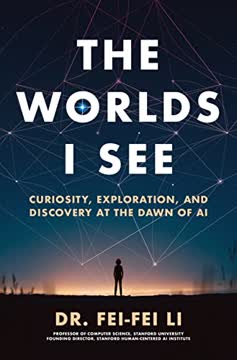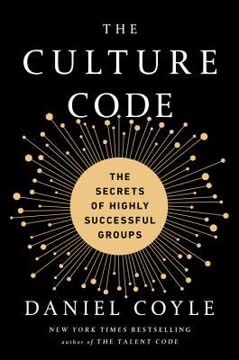Key Takeaways
1. Culture is built through actions, not identity
Your Culture = Your Actions
Actions shape culture. Culture is not a predetermined quality based on a group's identity, but rather a skill that can be learned and improved through deliberate actions. High-performing organizations focus on creating and reinforcing behaviors that align with their desired culture. These actions include fostering psychological safety, encouraging vulnerability, and consistently communicating purpose.
Small actions matter. Seemingly minor behaviors, such as expressing gratitude, sharing personal stories, or consistently following through on commitments, can have a significant impact on cultural development. Leaders play a crucial role in modeling these behaviors and setting the tone for the entire organization.
Key cultural actions:
- Overthanking people
- Using inclusive language
- Sharing failures and learnings
- Celebrating diverse perspectives
- Consistently linking daily work to larger purpose
2. Safety is the foundation of strong cultures
We are connected.
Psychological safety enables growth. When team members feel safe to take interpersonal risks, they are more likely to speak up, share ideas, and contribute fully. This environment of trust and openness is essential for innovation, problem-solving, and continuous improvement.
Safety is built through belonging cues. Leaders can foster psychological safety by consistently sending signals that reinforce connection, shared future, and individual value. These cues can be verbal (e.g., asking for input) or non-verbal (e.g., attentive body language).
Strategies to build safety:
- Eliminate "brilliant jerks" who undermine team dynamics
- Use inclusive icebreakers to build connections
- Practice active listening and "overthanking"
- Create opportunities for informal interactions
- Normalize discussions about mental health and well-being
3. Vulnerability precedes trust in high-performing teams
When people take interpersonal risks together, they connect and cooperate far more deeply.
Vulnerability builds trust. Contrary to common belief, vulnerability is not a result of trust, but rather a precursor to it. When team members are willing to show their weaknesses, admit mistakes, and ask for help, it creates an environment of mutual support and deeper connection.
Leaders must model vulnerability. When those in positions of authority demonstrate vulnerability, it sends a powerful signal that it's safe for others to do the same. This can take the form of admitting mistakes, sharing personal challenges, or actively seeking feedback.
Ways to encourage vulnerability:
- Share "best of me" documents outlining personal strengths and weaknesses
- Implement regular "anxiety parties" to discuss concerns
- Use "flash mentoring" for quick, candid exchanges
- Celebrate failures as learning opportunities
- Practice "warm candor" when delivering feedback
4. Embrace productive conflict and learn from mistakes
Strong cultures don't transcend tensions; they embrace them and use them as cultural fuel.
Conflict drives innovation. Healthy disagreement and debate are essential for generating new ideas and solving complex problems. Organizations that avoid conflict often stagnate, while those that embrace it as a tool for growth tend to thrive.
Learning from mistakes is crucial. High-performing cultures view failures as valuable learning opportunities rather than sources of shame. By openly discussing and analyzing mistakes, teams can improve processes, avoid future pitfalls, and foster a growth mindset.
Techniques for productive conflict and learning:
- Distinguish between task conflict (ideas) and relationship conflict (personal)
- Implement regular After-Action Reviews (AARs)
- Create a "failure wall" to showcase and learn from mistakes
- Use the "subtraction game" to eliminate unnecessary processes
- Encourage leaders to occasionally "disappear" to empower team problem-solving
5. Effective feedback focuses on reflection, not judgment
Instead of pushing feedback on someone, seek to create a reflective pull.
Self-reflection promotes growth. Rather than relying solely on top-down feedback, effective cultures encourage individuals to reflect on their own performance and areas for improvement. This approach fosters ownership and intrinsic motivation for growth.
Ask powerful questions. Instead of giving direct feedback, leaders can ask questions that prompt reflection and self-discovery. This method helps individuals identify their own strengths and weaknesses, leading to more meaningful and lasting change.
Reflection-promoting questions:
- "What do you think you should do more of?"
- "What might you do differently?"
- "How does this align with our purpose?"
- "What impact did your actions have on others?"
- "What would make this even better next time?"
6. Purpose is communicated through stories and symbols
Stories light up our brains—assigning value, igniting emotion, providing models for behavior—and stick in our memories twenty-two times more powerfully than mere information.
Stories create meaning. Powerful narratives that illustrate an organization's values, challenges, and successes help team members connect their daily work to a larger purpose. These stories become part of the cultural DNA, shaping behavior and decision-making.
Symbols reinforce purpose. Physical artifacts, catchphrases, and rituals serve as constant reminders of an organization's mission and values. These tangible representations of culture help maintain focus and alignment, especially during challenging times.
Types of purpose-reinforcing elements:
- Origin stories that highlight founding principles
- Customer impact stories that showcase real-world value
- Crisis stories that demonstrate resilience and problem-solving
- Innovation stories that celebrate creative thinking
- Visual artifacts that represent core values
- Catchphrases and mantras that encapsulate key principles
7. Regular cultural check-ins maintain organizational health
Strong cultures do culture captures for the same reason you get a yearly physical exam.
Culture requires ongoing attention. Just as physical health benefits from regular check-ups, organizational culture needs consistent monitoring and care. Regular assessments help identify strengths, weaknesses, and areas for improvement before small issues become major problems.
Involve the entire organization. Cultural health checks should involve input from all levels of the organization to get a comprehensive view. This inclusive approach not only provides valuable insights but also reinforces the idea that everyone plays a role in shaping and maintaining culture.
Elements of a cultural health check:
- Anonymous surveys to gather honest feedback
- Small group discussions to dive deeper into issues
- Leadership reflection on alignment with stated values
- Review of key performance indicators linked to cultural goals
- Action planning to address identified areas for improvement
8. Remote work requires intentional connection-building
Virtual is voluntary. If you want them to engage, you need to get them actively creating something or, better, creating in groups.
Proactive engagement is key. In remote work environments, the casual interactions that naturally occur in physical spaces must be intentionally cultivated. Leaders and team members need to make extra effort to create opportunities for connection and collaboration.
Leverage technology creatively. While video calls are important, they shouldn't be the only tool for remote connection. Utilize a variety of digital platforms and techniques to foster engagement, creativity, and team bonding.
Strategies for remote connection:
- Virtual coffee breaks or "hallway" chats
- Digital whiteboards for collaborative brainstorming
- Asynchronous video messages for updates and check-ins
- Online team-building games and activities
- Virtual tours of personal workspaces
- Rotating "bleacher seats" in meetings for observational learning
9. Diversity and inclusion create belonging and drive success
Belonging is when you actively love the dancing.
Beyond representation. True inclusion goes beyond having diverse team members; it involves creating an environment where everyone feels valued, heard, and able to contribute fully. This sense of belonging leads to higher engagement, creativity, and overall performance.
Equity requires ongoing effort. Building an inclusive culture is an ongoing process that requires consistent attention, self-reflection, and willingness to change. Organizations must actively work to identify and address biases, create equitable systems, and foster an environment of mutual respect and understanding.
Actions to promote diversity, equity, and inclusion:
- Implement bias-aware hiring and promotion practices
- Provide regular diversity and inclusion training
- Create employee resource groups for underrepresented populations
- Establish mentorship programs to support career development
- Regularly assess and address pay equity
- Celebrate diverse perspectives and cultural backgrounds
Last updated:
FAQ
What's "The Culture Playbook" about?
- Author and Purpose: "The Culture Playbook" by Daniel Coyle is a guide designed to help groups build and sustain successful cultures through actionable steps.
- Core Idea: The book argues that culture is not a fixed trait but a skill that can be developed through specific actions.
- Structure: It provides 60 field-tested actions divided into three main sections: Building Safety, Sharing Vulnerability, and Establishing Purpose.
- Practical Approach: The book is a practical manual, offering exercises, tips, and conversation starters to improve group dynamics and culture.
Why should I read "The Culture Playbook"?
- Actionable Insights: The book offers practical, actionable steps to improve group culture, making it useful for leaders and team members alike.
- Diverse Examples: It draws on examples from successful organizations like Pixar, the U.S. Women’s National Soccer Team, and the San Antonio Spurs.
- Skill Development: It emphasizes that culture is a skill that can be learned and improved, providing a roadmap for continuous development.
- Comprehensive Guide: With 60 actions, it covers a wide range of scenarios and challenges, making it a comprehensive resource for anyone looking to enhance their group's culture.
What are the key takeaways of "The Culture Playbook"?
- Culture Equals Actions: Culture is defined by what you do, not who you are, and it can be improved through deliberate actions.
- Three Key Behaviors: The book focuses on building safety, sharing vulnerability, and establishing purpose as the foundation of strong cultures.
- Practical Exercises: It includes exercises and tips to help groups assess their current culture and implement changes.
- Continuous Improvement: The book encourages ongoing reflection and adaptation to maintain and strengthen group culture.
How does Daniel Coyle define culture in "The Culture Playbook"?
- Action-Based Definition: Coyle defines culture as the sum of actions taken by a group, emphasizing that it is not a static trait.
- Skill, Not Gift: He argues that culture is a skill that can be learned and improved, rather than a gift that some groups have and others don't.
- Dynamic and Evolving: Culture is always changing, and groups must continually adapt and respond to maintain a strong culture.
- Living Relationships: It consists of living relationships working toward a shared goal, built by the actions taken together.
What is the "Building Safety" section about in "The Culture Playbook"?
- Psychological Safety: This section focuses on creating an environment where everyone feels safe to speak up and contribute.
- Belonging Cues: It emphasizes the importance of belonging cues—behaviors that signal connection, care, and shared future.
- Practical Tips: Includes tips like "Zero Tolerance for Brilliant Jerks" and "Make a Habit of Overthanking People" to foster safety.
- Goal: The overarching goal is to create an environment where everyone knows they can speak up when it counts.
What does "Sharing Vulnerability" mean in "The Culture Playbook"?
- Trust Through Vulnerability: This section highlights that trust is built through shared vulnerability, not the other way around.
- Vulnerability Loops: It introduces the concept of vulnerability loops, where people admit they don't know the answers and share weaknesses.
- Discomfort as Growth: Encourages embracing discomfort as a necessary part of building trust and strengthening group dynamics.
- Practical Actions: Offers actions like "Signal Fallibility Early and Often" and "Build the AAR Habit" to foster vulnerability.
How does "The Culture Playbook" suggest establishing purpose?
- Purpose as a Guide: Purpose is described as a set of guiding principles that help navigate the complexities of group life.
- Collaborative Process: Establishing purpose involves a collaborative and organic process, not just a top-down mission statement.
- Optimism and Hope: The book emphasizes building purpose on a foundation of optimism and hope, focusing on positive visions.
- Practical Tools: Includes tools like "Create a Mantra Map" and "Do a Best/Barrier Workshop" to help groups define and communicate their purpose.
What are some of the best quotes from "The Culture Playbook" and what do they mean?
- "Your Culture = Your Actions": This quote encapsulates the book's core idea that culture is defined by what you do, not who you are.
- "Vulnerability doesn’t come after trust—it comes before": Highlights the importance of shared vulnerability in building trust within a group.
- "Optimism is a core principle of good leadership": Emphasizes the role of optimism in guiding a group toward a positive vision and purpose.
- "Culture is not magic, and it’s never written in stone": Reinforces the idea that culture is dynamic and can be shaped through deliberate actions.
What is the "Zero Tolerance for Brilliant Jerks" tip about?
- No Jerks Policy: This tip advises against tolerating high-performing individuals who exhibit toxic behavior.
- Belonging Cue: A zero-tolerance policy sends a strong signal that no one is more important than the group.
- Practical Steps: Includes assessing potential hires for jerk-like behavior and consistently broadcasting the "no jerks" message.
- Group Performance: Research shows that groups valuing civility are more likely to share information and perform better.
How does "The Culture Playbook" address remote work challenges?
- Cool-Kid Bias: The book warns against the bias that in-office work is more valuable than remote work.
- Communication and Connection: Emphasizes overcommunicating office happenings and spotlighting remote work benefits.
- In-Person Interactions: Suggests using in-person interactions like a booster shot to strengthen remote teams.
- Practical Tips: Offers tips like "Make a Weekly Outer-Circle Phone Call" to maintain connections in remote settings.
What is the "After-Action Review" (AAR) habit in "The Culture Playbook"?
- Trust-Building Tool: AAR is a tool for building trust by discussing the strengths and weaknesses of a group's performance.
- Three Questions: It involves asking what went well, what didn’t, and what will be done differently next time.
- Learning Together: The goal is to create clarity and learn together, not to assign credit or blame.
- Proven Effectiveness: Originating in the military, AARs have been shown to improve performance and teamwork.
How can "The Culture Playbook" help in building racial equity and belonging?
- Belonging Over Diversity: The book emphasizes creating belonging, not just diversity and inclusion.
- Uncomfortable Conversations: Encourages normalizing conversations about systemic racism and bias.
- Practical Actions: Offers actions like "Normalize Uncomfortable Conversations" and "Read, Watch, and Reflect Together."
- Continuous Learning: Stresses the importance of ongoing learning and self-examination to build racial equity and belonging.
Review Summary
The Culture Playbook receives mostly positive reviews, with readers praising its practical tips for improving group dynamics and workplace culture. Many find the book's 60 actionable ideas helpful, especially for managers and team leaders. Some reviewers note that the book builds on Coyle's previous work, "The Culture Code," and appreciate its focus on remote work scenarios. While some find certain tips repetitive or specific to corporate environments, most agree that the book offers valuable insights for fostering better team cultures.
Similar Books










Download PDF
Download EPUB
.epub digital book format is ideal for reading ebooks on phones, tablets, and e-readers.







